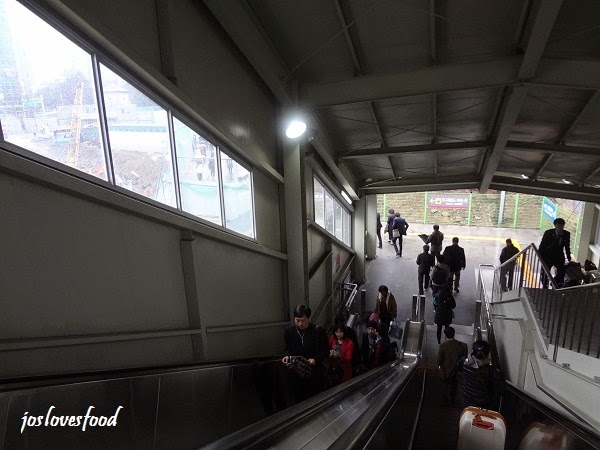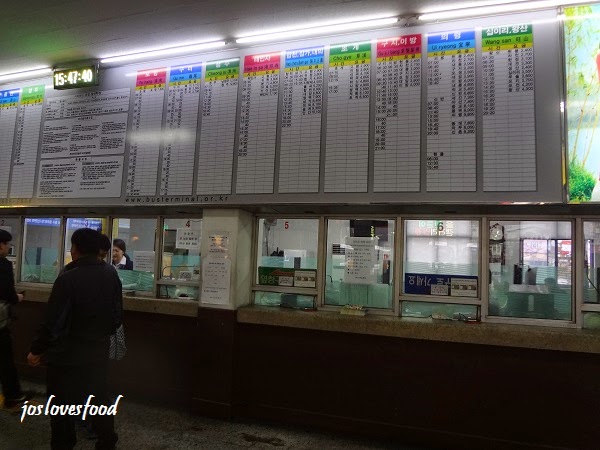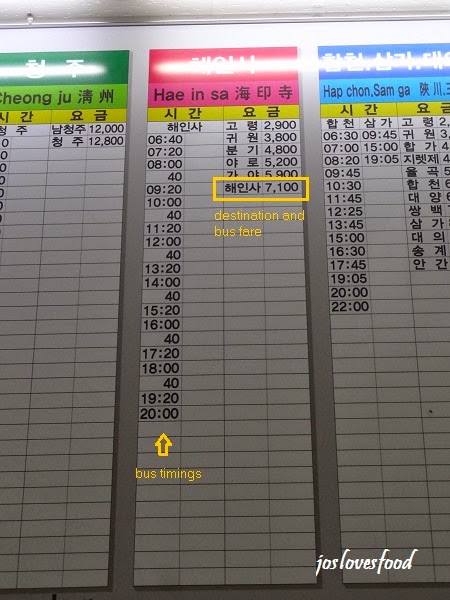Travelling in Seoul has always been a breeze for me. However, getting out there, out of Seoul may seem like getting out from our soul. It can be scary but fret not. Korea's transportation system is pretty good. Some tips to share:
1. Load your T-money card with extra value as most of the transportation system (buses, metro and even KTX) would accept using the T-money and in case, you can't find a reload machine while in a hurry to catch the arriving bus. However, intercity buses may not accept the use of T-money because the fare may differ from timing to timing because the bus operator may be different.
2. Keep some small notes and loose change in case your T-money card runs out of value. The fare for local buses costs 1,100 to 1,200 per trip regardless of distance.
3. Ensure you have data-plan on your mobile device and not to just rely on free wifi. In case you need to check the location map or the translation app at some rural cities.
4. Travel light. Backpacks and lightweight jackets would be good. While inter-city buses have separate luggage storage compartment, this is not the case for local buses. You will need to lug your luggage onboard and hold tight to them so that the luggage will not roll away.
5. Bring some heat packs (especially during the colder seasons). Food and drinks are optional as you can purchase them on KTX.
6. Have your headphones if you wish to plug in to listen to their local radio channels.
Ready, get set, go to Haeinsa!
Here's the details about the journey to Haeinsa. From Seoul Station, we took the KTX (Korean Train Express) to Dong Daegu Station. (Note: There is Daegu and Dong Daegu station, be sure to buy tickets for the correct destination.) KTX is the high speed train system in Korea that runs from Incheon Airport to various parts of Korea such as Busan, Yeosu, Mokpo and Gwangju. Information about KTX travel and reservation information can be found here. You can either reserve tickets online (so that you can secure the seats ahead of departure) or get the tickets at the counter.
This is the entrance to Seoul Station, which is a really huge station for passenger transit station be it for KTX train, rail train or subway train.
This is the ticketing counter, which is visible the moment you enter the train station entrance. There are separate queues for those who reserved tickets online and those buying on the spot.
On the ticket, it shows the travelling date (Year/Month/Date) and time. The subsequent lines show the train number (KTX 133), the cabin number (No. 14) and Seat number (2B). On the right, it shows the departure destination (Seoul) and arrival destination (Dong Daegu). Beneath that, it shows the fare amount (42,500 won). Unfortunately, it doesn't state the estimated arrival time.
Once you have gotten the tickets, check the digital signboard for the platform number that you ought to be heading towards.
Take the correct lift that brings you to the track. The huge numbers plastered at the lift's side door denotes that platform which the lift will bring you to.
Each lift serves 2 platforms/tracks.
At the platform itself, the hanging signage indicates the direction in which the incoming train is heading towards.
Look out for the floor signage which indicates the cabin number.
The KTX trains have overhead storage compartment for small luggages. Bigger ones are to be stored at the separate compartment near the train doors. Do note that the seats are not rotatable. Hence you may be assigned seats that are in the opposite direction of the moving train.
The journey from Seoul Station to Daegu Station took about 1 hour 55 mins.
Here's the transfer direction to the Dong Daegu metro station. Upon exiting the to the public area at the ground level, turn left and walk straight.
There are lots of shops and restaurants on both aisles.
Once you see the Andong Bakery Shop, turn right and exit the station via Exit 2.
Go along the sheltered walkway.
After the exit, take the downward-riding escalator. There is an elevator next to the escalator which can be used if you have a heavy luggage.
Once you reach the ground level, turn left. The metro station entrance will be just around the corner. To use the elevator, do not enter the entrance. Instead, follow the pedestrian path and keep walking.
Take the metro to Seong Dang Mot (성당못) station (station number 123). The journey from Dong Daegu will take about 20 mins.
Take the elevator from the train platform level to the gantry level.
Look out for the signage pointing to the Seobu Bus Terminal and take the elevator.
Once you exit the elevator, turn right and look out for the words "TIM" on the low building. That's the shortcut and back entrance to get into the intercity bus terminal.
As this is an intercity bus terminal, there are buses that bring passengers to different parts of Korea.
This pink signage provides the bus departure timings, the names of bus stops along the way to Haeinsa and the corresponding bus fare. So.... Haeinsa is the last stop and the fare was 7,100 won (approximately USD 7).
The bus ticket will show the platform number for the bus departing for Haeinsa.
There are a couple of snacks stalls and coffeeshops at the bus terminal.
Exit the ticketing area to get to the bus bay for boarding. These intercity buses have luggage compartments. However, the bus drivers will be assist with the loading of luggage. Be prepared to DIY!
If you do not understand Hangeul, at least make sure you can recognize the characters for the destination that you are heading to. For example, 해인사 means Haeinsa. Double-check the destination of the bus before boarding.
The seats on the buses are quite comfortable. Eating and drinking are allowed onboard.
After about 1.5 hours' journey, we finally arrived at Haeinsa bus stop. This is the last stop for the route. A couple of things to note:
1. The bus will stop at Haeinsa's ticketing entrance and you are required to pay for a 3,000 won admission ticket to the temple.
2. It is not advisable to alight at the admission ticketing stop because it is a very long walk into Haeinsa and if you do so, you may get lost in the compound which is really huge.
3. The temple is nowhere in sight when you alight at the Haeinsa bus stop. The buildings opposite the bus stop are guesthouses and hotels for temple visitors, I suppose.
To get to Haeinsa, you will need to transfer to a taxi. It is a 5-minute journey and the standard fare is 5,000 won. This is not a metered-fare and there is no need for negotiation with the taxi driver.
We finally figured out that we needed to take a taxi and were finally on our way to Haeinsa.
We finally, finally arrived at Haeinsa. This is the dormitory building for temple-stay participants.
To get to the temple-stay office for registration (registration timing is between 3pm to 4pm), enter through the small traditional door at the left-end of this building and take the stairs up 1 level.
It is a short flight of stairs. But, if you have a heavy luggage, you can choose not to lug it up.
Once you reach the upper level, turn right and look for the temple-stay office!
And Yes! Welcome to Haeinsa Temple-stay Programme!!
To get a better orientation about the location of Haeinsa, check out this map! And if you're interested to know more about the buildings within the temple, stay tuned for my next blog post! :D






































Hey, i just used your tips, and even if your post is dated as of 2005, it has been pretty useful, thanks!!
ReplyDeleteSo glad (and relieve) to know the tip is still is useful!
Delete